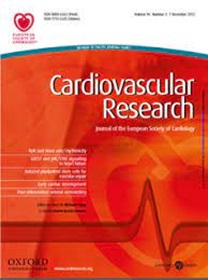绘制肺动脉高压发展过程中负责闭塞动脉重塑的疾病特异性血管细胞群
IF 13.3
1区 医学
Q1 CARDIAC & CARDIOVASCULAR SYSTEMS
引用次数: 0
摘要
肺动脉高压(PAH)是一种致命的肺血管疾病,其特征是小动脉修剪和闭塞性血管重塑,导致肺血管阻力增加,最终导致右心衰。虽然内皮细胞(EC)损伤和凋亡是这种疾病的已知诱因,但它们导致复杂动脉重塑的机制仍不清楚。我们在严重PAH模型的发病和进展过程中多个时间点采用多重单细胞RNA测序,以确定闭塞性动脉病变发展的机制。方法和结果单细胞转录分析确定了44个全球肺细胞群,在1周时广泛的早期转录组变化影响内皮细胞,间质细胞和免疫细胞群。特别是,在PAH的发展过程中,两个EC簇大大扩大,并被确定为疾病特异性:一个相对去分化(dD) EC群体,Cd74表达丰富,同时表现出内皮身份的丧失;激活动脉EC (aAEC)群体在整个PAH发展过程中独特地表现出持续的差异基因表达,与生长调节状态一致。主要EC转录因子Erg和Fli1的活性降低证明了dDECs经过内皮-间质转化,并进一步得到RNA速度分析的支持,显示载体导致成纤维细胞簇。值得注意的是,aAECs高表达Tm4sf1,这是一种与癌细胞生长有关的基因,也由平滑肌样周细胞簇表达,并且在大鼠模型和PAH患者中高度定位于动脉重塑区域,导致内膜闭塞病变和SM样周细胞形成内侧肌肉化带。综上所述,这些发现暗示疾病特异性血管细胞参与PAH的进展,并提示TM4SF1可能是动脉重构的新治疗靶点。通过对人肺样本和严重PAH大鼠模型的单细胞转录组学分析,我们已经确定了导致复杂动脉重塑的疾病特异性EC群体,包括生长失调、活化的动脉ECs (aAECs)和去分化的ECs (dDECs),这些ECs可能会引发内皮细胞向间质细胞的转变。特别是,aaec表现出高表达的表面标记物TM4SF1,这是其超增殖表型所必需的,代表了RNA沉默方法的有希望的治疗靶点或作为抗原来指导PAH中这种癌症样EC群体的免疫介导消融。本文章由计算机程序翻译,如有差异,请以英文原文为准。
Mapping disease-specific vascular cell populations responsible for obliterative arterial remodeling during development of pulmonary arterial hypertension
Background Pulmonary arterial hypertension (PAH) is a lethal pulmonary vascular disease characterized by arteriolar pruning and occlusive vascular remodeling leading to increased pulmonary vascular resistance and eventually right heart failure. While endothelial cell (EC) injury and apoptosis are known triggers for this disease, the mechanisms by which they lead to complex arterial remodeling remain obscure. Aims We employed multiplexed single-cell RNA sequencing at multiple timepoints during the onset and progression of disease in a model of severe PAH to identify mechanisms involved in the development of occlusive arterial lesions. Methods and Results Single cell transcriptional analysis resolved 44 global lung cell populations, with widespread early transcriptomic changes at 1 week affecting endothelial, stromal and immune cell populations. In particular, two EC clusters were greatly expanded during PAH development and were identified as being disease specific: a relatively dedifferentiated (dD) EC population that was enriched for Cd74 expression while exhibiting a loss of endothelial identity; and an activated arterial EC (aAEC) population that uniquely exhibited persistent differential gene expression throughout PAH development consistent with a growth regulated state. dDECs were primed to undergo endothelial-mesenchymal transition as evidenced by reduced activity of master EC transcription factors, Erg and Fli1, and further supported by RNA velocity analysis showing vectors leading to fibroblast clusters. Of note, aAECs exhibited high expression of Tm4sf1, a gene implicated in cancer cell growth, that was also expressed by a smooth muscle (SM)-like pericyte cluster, and were highly localized to regions of arterial remodeling in both the rat model and PAH patients, contributing to intimal occlusive lesions and SM-like pericytes forming bands of medial muscularization. Conclusions Together these findings implicate disease-specific vascular cells in PAH progression and suggest that TM4SF1 may be a novel therapeutic target for arterial remodeling. Translational Perspectives Using single cell transcriptomic analysis in both human lung samples and a rat model of severe PAH we have identified disease-specific EC populations contributing to complex arterial remodeling, including growth-dysregulated, activated arterial ECs (aAECs) and dedifferentiated ECs (dDECs) that may be primed for endothelial to mesenchymal transition. In particular, aAECs exhibit high expression of a surface marker, TM4SF1, which is essential for their hyper-proliferative phenotype and represents a promising therapeutic target for RNA silencing approaches or as an antigen to guide immune-mediated ablation of this cancer-like EC population in PAH.
求助全文
通过发布文献求助,成功后即可免费获取论文全文。
去求助
来源期刊

Cardiovascular Research
医学-心血管系统
CiteScore
21.50
自引率
3.70%
发文量
547
审稿时长
1 months
期刊介绍:
Cardiovascular Research
Journal Overview:
International journal of the European Society of Cardiology
Focuses on basic and translational research in cardiology and cardiovascular biology
Aims to enhance insight into cardiovascular disease mechanisms and innovation prospects
Submission Criteria:
Welcomes papers covering molecular, sub-cellular, cellular, organ, and organism levels
Accepts clinical proof-of-concept and translational studies
Manuscripts expected to provide significant contribution to cardiovascular biology and diseases
 求助内容:
求助内容: 应助结果提醒方式:
应助结果提醒方式:


